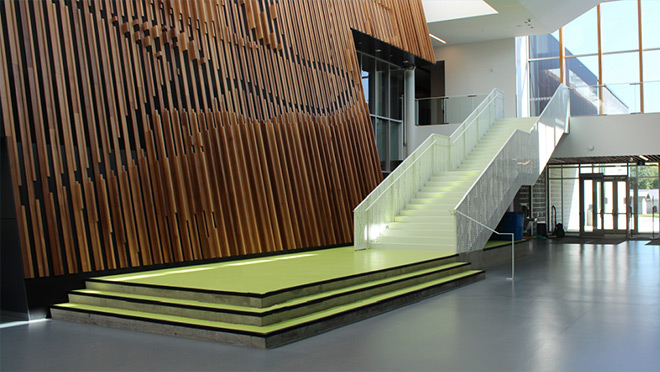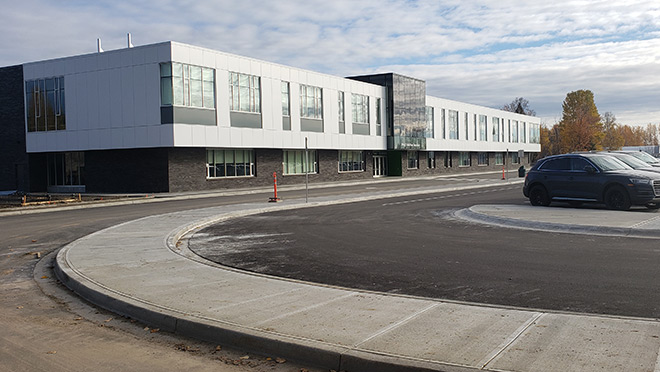Going green: B.C. schools get sustainable, from the ground up

Engineers, teachers, and students are all in this together
Imagine a time in the future when everything at a school is examined for how it affects sustainability. Imagine a day when everyone – from architects and engineers, to teachers and students – has a role to play in creative solutions for greener schools.
That time is now, right here in B.C.
All across the province, schools are getting greener in ways big and small:
- School districts that need to renovate or rebuild to meet updated seismic standards jumped at the chance to do energy-efficiency upgrades at the same time.
- There are over 40 electric school buses now in use for K-12 students at B.C. schools, and the number is growing.
- More than 200 B.C. schools now use air source heat pumps as part of fuel-switching initiatives aimed at avoiding the use of fossil fuels.
- A Maple Ridge teacher prompted by memories of rolling blackouts in her native El Salvador encourages sustainability, inside and outside her school.
- A rebuilt high school in Prince George showcases how ground-up design can maximize energy efficiency.
- At Canada's greenest school, students and teachers joined forces to help add vertical greenhouses, bottle refilling stations, and to cut food waste.
Sustainability is no longer just something students consider for part of the school year and teachers cross off the to-do list. It's now a basic expectation that's being embraced by school districts, teachers, and students. And the bar is being raised as green building practices hit the mainstream.
Did you know? According to the World Green Building Council, features that go into making a building "green" range from efficient use of energy, water and resources, to waste reduction measures that include enabling re-use and recycling.
Embedding sustainability in our curriculums
Delivering on all those green elements is going to take a concerted effort from all involved in schools.
"What we want to do is go beyond where we have a few teachers who are passionate advocates," says Jonathan Ho, Richmond School District's manager of energy and sustainability. "What's really important is embedding sustainability, so that it's a big part of the curriculum."
Ho cites two examples of how that's being done in Richmond. One is taking aspects of the school district's electric vehicle toolkit and integrating it into the district's STEM program for students in grades 8 through 12. Another is the Richmond Sustainability Advisory Committee, a group that promotes projects through a collaboration between teachers, students, and parents.
A recent highlight for Ho? After Ho chatted about sustainability with a Social Justice 12 class, the teacher of the class emailed him to tell him that the talk inspired a student to seriously consider sustainability as a career, something they hadn't known existed before the presentation.
"The kid was like, 'Wow, I could really do something with this," says Ho, an engineer by training who is also the board chair of the BC Sustainable Energy Association. "That was a really cool thing for me, and it certainly wasn't my intent. That path could change this kid's life."
There is no shortage of job opportunities in sustainability. A recent search on a job-finding website found more than 700 sustainability related positions in B.C., ranging from a conservation and climate change manager for the City of Kelowna, to environmental monitors, fisheries biologists, and an environmental coordinator for a Burnaby recycling operation.
Canada's greenest school embraces sustainability pledge
An early adopting environmentalist who installed solar panels at his home way back in 1976 is now a teacher and environmental steward at Richmond's Ferris Elementary. Kevin Lyseng not only introduced a district-wide Eco-Wise Sustainability Pledge, he helped Ferris earn the lofty status of the greenest school in Canada.
"There are many projects that relate to energy, and their impacts overlap," Lyseng said in a scienceworld.ca story on the school in December. "It's a complicated story, as is conservation. Put simply, when kids leave here, they have green thoughts."
Ferris won the "greenest school" award in 2019, the most recent year the Canada Green Building Council has run the awards competition (it's on hold because of the COVID-19 pandemic). A panel of experts in green buildings chose Ferris from a list of applications from across the country, noting how the school encouraged active transportation, the reduction of waste, water and energy.
Green moves at Ferris include:
- Vertical greenhouses and garden beds in the library courtyards
- "Reverse lunches", in which students play outdoors before they eat, which has added up to surging appetites and a 20-fold reduction in wasted food in the school's garbage containers
- A tree-planting program to provide students with shade from the sun.
- Purchase and installation of water bottle refilling stations to encourage re-use of bottles and cut down on plastic waste.
Prince George high school updates name and energy efficiency
A Prince George High School shows, more than any other school in School District No. 57, the potential of designing a school for energy efficiency from the ground up.
Not only was the school renamed to include "Shas Ti", which means "grizzly trail" or "grizzly path" in the Dakelh dialect of the Lheidli T'enneh First Nation. The new Shas Ti Kelly Road Secondary is an aesthetic and efficiency gem, riddled with wooden elements and boasting energy-saving features expected to save more than 448,000 kilowatt hours of electricity each year.
That's enough electricity to power 45 homes per year.
"We have all of this technology at other individual locations throughout our district, but this is the first opportunity we've had to build it and bring it all together as a collection of all the things we've learned," says Barry Bepple, the school district's sustainable conservation coordinator.
Technologies used at the school, which leaned on our New Construction Program to inform energy-efficient design, include:
- A high-efficiency ground-source heat pump system as part of a system that provides each classroom with independent heating and cooling. Teachers can adjust the temperature for day-to-day conditions.
- LED lighting that uses light sensors to tell if a room is occupied or not, and which adjusts the output of the lights automatically to take advantage of daylight.
- High-performance windows, along with increased roof and wall insulation.
How does a heat pump work? Learn more about the technology.
An electric bus saves about 17 tonnes of GHG emissions each year
There are over 54,000 EV cars and trucks registered in B.C., and the province is well on the way to exceeding its 2025 targets: 9.4% of all new B.C. light-duty vehicle sales were EVs in 2020.
But what about buses?
A zero-emission electric school bus saves about 17 tonnes of greenhouse gas emissions every year compared to a diesel school bus. That's why the BC Ministry of Education initially funded 13 school districts to purchase 18 electric buses in time for the 2021-2022 school year. And there are now more than 40 electric buses in use by schools.
"We have two buses, and our drivers love them," says Pete Godau, director of facilities at School District 62 in Sooke. "They had a raffle to decide who would get to drive them! They're working fine, doing two routes in the morning and two in the afternoon. That's up to two hours at a time."
Learn more about B.C.'s electric school buses
Memories of rolling blackouts drive Maple Ridge teacher
The memory of rolling blackouts in war-torn El Salvador more than 30 years ago plays a pivotal role in the eco-consciousness of Maple Ridge teacher Carla Van Der Pauw.
"From a very young age, I knew the importance of electricity," Van Der Pauw explained in a story earlier this year on scienceworld.ca. "Its unpredictability only made me appreciate it more."
Van Der Pauw and her family arrived in Canada as refugees when she was nine. But today she's the teacher sponsor for the Eco-Action Group at Thomas Haney Secondary in School District 42. Boosted by our Energy Challenge, the group has started in-school efforts including unplugging appliances, installing water-bottle refill stations, and running a composting pilot project with worm bins and solar cones.
She's also urging her students to look beyond the school for ways to make B.C. – and the world – more sustainable. And she was overjoyed to learn that one of her former students, Jaden Dyer, led a hunger strike in an effort to convince Simon Fraser University administration to divest itself from fossil fuels. SFU agreed, pledging to fully divest itself from fossil fuels by 2025.
"Accepting our ultimatum will not only have an immediate impact, but a rippling one that will shift cultural attitudes towards the use of fossil fuels worldwide," Dyer told the media during the protest.
Power Smart for Schools offers activities and lessons
Our Power Smart for Schools program matches sustainability-related activities and lessons to the B.C. school's curriculum, mapping them by age to ensure they're appropriate for each grade level. And several activities help teachers and students bring sustainability to their schools.
Here are a few examples of what's offered on the Power Smart for Schools website:
- What are green buildings? (Grades 10-12)
- Shifting our transportation mindset (Grades 6-8)
- Science of climate change (Grade 7)
- Biodiversity and white sturgeon in B.C. (Grade 3)
- Life cycle of a plastic bottle (Grade 9)
- Design an energy-efficient home (Grades 10-12)
- T'Sou-ke First Nation: solar powered (Grades 6, 7)
- School energy investigation (Grade 7)
- What really happens to the plastic you throw away? (Grades 5, 7)
- Ecosystem goods and services (Grades 11-12)
Related:
